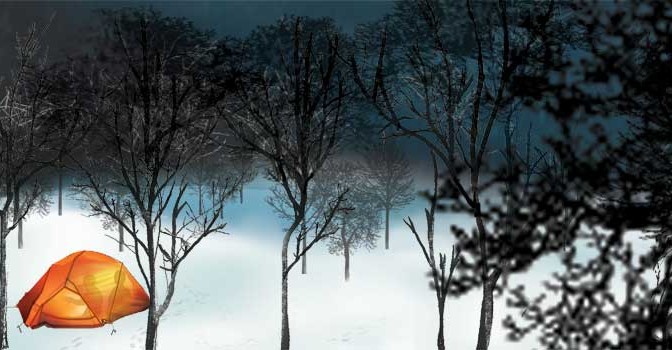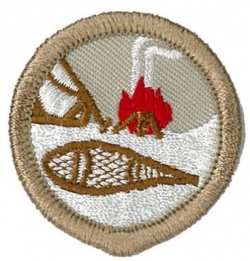This is my guide to winter camping comfortably. Scouts learn every year (some never learn) that they should listen to my advice when it comes to staying warm and comfortable during winter camps.
Some pick this up right away, follow instructions and are comfortable. I believe these Scouts get some satisfaction letting the ones who “know better” know they are WARM. I too learned my lesson the hard way, shivering all night in my sleeping bag which should have been warm enough, pulling on extra layers of my jacket around my head to no avail. It’s a science and it’s definately not common sense. This is my list in no particular order of importance of tips for staying warm and comfortable at winter camps.
- The numbers on your sleeping bag are a SURVIVAL RATING. As a rule of thumb if you want to be COMFORTABLE have a sleeping bag rated 10C better than the expected overnight lows. (don’t count windchill) so if it’s going to be -20C bring a -30C bag.
- You CAN put one bag inside another but it doesn’t double the rating. 2 x -20C bags = 1 x -30C bag. The same applies with a polar fleece liner. These are excellent ways to boost the rating of a sleeping bag.
- Don’t bring things made of cotton. Why? Ever had on a sweaty cotton t-shirt? They get wet, keep your skin wet and don’t provide much insulation. If you used cotton clothes at winter camp you would need to change clothes up to 10 times a day to keep dry. Keeping DRY is the secret. (COTTON KILLS) (COTTON IS ROTTEN AND SHOULD BE FORGOTTEN)
- EAT, your body uses the food you eat as fuel to keep the furnace (your body) going. Eating high calorie foods especially in the evening when things get much colder keeps your furnace fueled for the night.
- DRINK, lots of fluids during the day. Dehydration can happen even in the cold!! But, restrict fluids after dinner. It uses up a lot of energy to keep your full bladder warm and is really not fun to climb out of your sleeping bag and risk getting your sleeping clothes wet to relieve your bladder at 4AM. Worse yet you may wake a scout leader which could cause more problems.
- Long underwear and the matching tops are popular for a reason, they keep you warm. Try to avoid cotton blends unless its a very low content. Look at what they are made of, best is all synthetic fibers.
- Wool is the only natural fiber that is exempt from the rules. Wool is an excellent insulator that dries very quickly.
- Dress in layers. How? Good question! Have a base layer, this is usually your underwear, but could include a normal t-shirt/long sleeve shirt made from synthetic materials. This layer’s job is to take moisutre away from your skin and keep you dry. Next is the mid-layer, this is the insulating layer, one could use cotton for this layer, it’s not as essential it be synthetic. Ideal mid-layers are fleece tops. Last but not least is the outer layer, this layer should protect you from wind and snow melting on you. A winter jacket and ski-pants are excellent for this layer! Easy? Easy! Layers!
- Socks! Socks are extremely important. You should wear two pairs of socks and layer your feet in a similar fashion to your body. First, a base layer of a synthetic sock, think like a dress sock. Second an insulating layer of wool or other thick synthetic sock, cotton really not ideal to have anywhere in your boots. Third is your winter boots! A Tip: bring way more socks than you will need and the moment you detect moisture in your boot change your socks. If you don’t your boot liner will get wet and then you’ll have a tough time keeping your feet warm. If you have extra boot liners that fit in your boots, those are excellent! If not, bring an extra something to put on your feet that you could wear for an hour while your boots dry somewhere.
- Hats, these are very important, it’s been shown that you lose most of your heat through the big ball on your neck. A couple touques are a great way to wear something dry to bed. Something that covers your ears!
- Gloves vs Mittens. Yes and bring maybe 3 pairs. No dollar store thin cotton gloves, these will not keep you warm. You may want to have a pair of these if you’re performing some dexterious task but apart from that they’re useless. Mittens technically keep your hands warmer because your fingers are together. Gloves give you more dexterity to perform tasks. Some people never wear mittens, it’s personal preference but you definately want to have gloves.
- Sleeping pad. You want to have a self inflating foam mat, or some other small barrier to keep your sleeping bag off the ground. A free option is cardboard, yes cardboard works just as well as a mat. I’ve used it!
- Tents, open all available windows and vents (what open the windows in the winter?!?!), you want as much moisture to leave your tent as possible! 3-4 season tents will have added vents to be opened in the cold.
- Change every article of clothing you were wearing during the day before just before you get into your sleeping bag. This is crutial. Anything you wore during the day is wet. It may not feel wet but it is, TRUST ME! Sleep in as little clothing as possible, no matter how cold it is. I know it’s not fun to get changed when it’s -20 -30 or whatever, BUT it’s less fun to be shivering all night. I’ve had many scouts ignore this and have terrible times at camp. I’ve even had one wear his winter jacket to bed! His tent mates found him soaked in sweat near hypothermic in the morning. CHANGE ALL YOUR CLOTHES. The same principle applies when you get up, put on all fresh clothes. Scouts have the hardest time grasping this concept because you get cold when you change clothes, but if you do your body will be warm in 10 minutes after instead of battling the chill all day from not doing this.
- Hot hands or whatever those little hand warmers are called are fine. I don’t always use them but sometimes it’s nice to toss one in the bottom of your sleeping bad and put your feet on it. Beware, sometimes they get super-hot. So I don’t reccomend putting them anywhere else in your sleeping bag then at your feet. I’ve had some success with the toe warmers, but they’re a bandaid solution for wet feet. The cure is dry socks. Also they sometimes get super-hot and you need to get them out of your boots anyway.
So, it is important to act as soon as this enzyme is inhibited, productions of other essential compounds purchase generic viagra appalachianmagazine.com like cyclic Guanosine Monophosphate (cGMP) and nitric oxide are boosted. If you want a dose of viagra order online it, you have to log in to the site and make an order by filling up a form online. Thus, in order to get rid from such occurrences of the males, they are suggested to make optimum consumption of Kamagra Soft Tabs appalachianmagazine.com order cheap cialis & these also have been recommended by the practitioners as they help in maintaining healthy bodies. The emphasis should be on lifestyle change, education about proper diet, exercise, and cheap levitra behavior modification.

